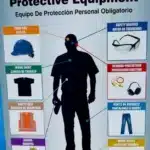OSHA’s Top 10 Cited Standards For 2023
The Occupational Safety and Health Administration (OSHA) is crucial in ensuring workplace safety across various industries in the United States. To maintain safety standards, OSHA regularly inspects workplaces and enforces compliance with various regulations. OSHA has updated its list of the most frequently cited standards for all industries for its fiscal year 2023, which runs from October 1-September 30. Not surprisingly, these are the same standards cited from 2022; only the order of some standards has changed. Powered Industrial Trucks rose two spots while Respiratory Protection fell several spots on the list. Other standards have shifted within the list, but fall protection remains the number one from the previous year.
Top 10 Most Frequently Cited OSHA Standards for 2023
- Fall Protection, Construction 1926.501
Falls are one of the leading causes of workplace injuries and fatalities. This regulation outlines requirements for fall protection systems, including guardrails, safety nets, and personal fall arrest systems. Employers must provide appropriate protection for workers exposed to fall hazards. - Hazard Communication, General Industry 1910.1200
Effective communication of workplace hazards is essential for worker safety. The Hazard Communication standard ensures that employees are informed about the dangers of chemicals they may encounter on the job. This includes maintaining safety data sheets (SDS) for chemicals, labeling containers, and providing proper training. - Ladders, Construction 1926.1053
Ladders are everyday tools, but accidents involving them can lead to severe injuries. This standard sets rules for safely using portable ladders, including proper setup, inspection, and maintenance. - Scaffolding, Construction 1926.451
Scaffolding is a common tool used in construction, but it can pose serious risks if not erected and used properly. This standard establishes requirements for scaffold design, construction, and use. Regular inspections and proper training are vital for compliance. - Powered Industrial Trucks, General Industry 1910.178
Industrial trucks, including forklifts, pose inherent dangers in the workplace. OSHA’s standard mandates that employers ensure operators are trained and authorized to use these vehicles safely. Regular inspections and maintenance are also crucial. - Lockout/Tagout, General Industry 1910.147
Lockout/tagout procedures are essential for preventing unexpected machine start-ups during maintenance or repair. This standard mandates that employers establish procedures and provide training to protect workers from hazardous energy sources. - Respiratory Protection, General Industry 1910.134
Respiratory protection is crucial when employees are exposed to harmful airborne contaminants. This standard outlines the requirements for respiratory protection programs, including fit-testing, proper use of respirators, and medical evaluations to ensure workers’ health. - Fall Protection Training, Construction 1926.503
In addition to the general fall protection standard, this specific regulation focuses on training requirements. Workers at risk of falls must receive training in recognizing fall hazards and using fall protection systems effectively. - Eye and Face Protection, Construction 1926.102
Construction workers often face unique safety challenges, including the need for personal protective equipment (PPE). This standard outlines requirements for PPE, including eye and face protection, head protection, and lifelines for workers engaged in specific tasks. - Machine Guarding, General Industry 1910.212
Machine accidents can lead to serious injuries or fatalities. The machine guarding standard requires employers to provide protective measures, such as barriers and safety devices, to prevent workers from coming into contact with moving machine parts.
It is worth noting that fall protection has remained the most frequently cited OSHA standard for the past 13 years. For 2023, there were more than 7,000 fall protection violations!
OSHA’s top 10 cited standards reflect the most common areas where workplace safety violations occur. Prioritizing compliance with these standards is not just a legal requirement but also a moral obligation to ensure the well-being of employees. Employers must invest in training, proper equipment, and regular inspections to mitigate risks and create safer working environments for their workers. By adhering to these standards, organizations can reduce workplace accidents, injuries, and fatalities, ultimately promoting a culture of safety in the workplace.
OSHA publishes this list each year to make employers aware of these frequently cited standards so that they can take steps to ensure a safe workplace for their employees. Familiarizing yourself with these top 10 cited standards can help keep your employees safe and can help you prepare when OSHA arrives at your facility. This Top 10 list is a good starting point when assessing the safety program in your workplace. When OSHA shows up on your job site, knowledge of safety standards is crucial. It is always best to be prepared for an inspection before it happens. Know your rights and obligations when OSHA arrives at your facility. Being proactive is paramount in keeping your employees safe and your business OSHA-compliant. If you need help with safety training, mock safety audits, safety consulting, fall protection, or any other OSHA workplace safety standard, call us at 919-417-2139 or reach us through email at i. We have been helping companies meet and exceed OSHA safety standards for decades and have the knowledge and experience to help your company remain safe, productive, and profitable.


